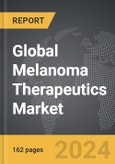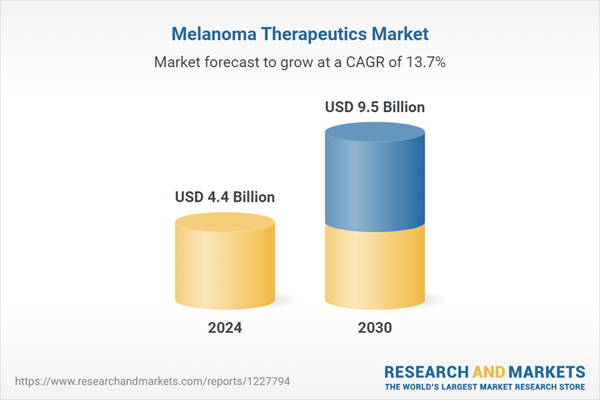The global market for Melanoma Therapeutics was valued at US$4.4 Billion in 2024 and is projected to reach US$9.5 Billion by 2030, growing at a CAGR of 13.7% from 2024 to 2030. This comprehensive report provides an in-depth analysis of market trends, drivers, and forecasts, helping you make informed business decisions. The report includes the most recent global tariff developments and how they impact the Melanoma Therapeutics market.
Targeted therapies have revolutionized melanoma treatment by focusing on specific genetic mutations associated with the disease. For instance, mutations in the BRAF gene, present in approximately 50% of melanoma cases, can be targeted with BRAF inhibitors like vemurafenib and dabrafenib. These drugs, often used in combination with MEK inhibitors such as trametinib and cobimetinib, have shown substantial improvements in patient outcomes by specifically attacking cancer cells while sparing healthy tissue. Immunotherapy has further propelled the field forward, with checkpoint inhibitors like pembrolizumab (Keytruda) and nivolumab (Opdivo) enhancing the body's immune response against melanoma cells. These therapies have demonstrated remarkable efficacy, leading to long-lasting remissions in some patients. Additionally, the development of combination therapies, which leverage the strengths of multiple treatment modalities, is an emerging trend that promises to further enhance therapeutic efficacy and overcome resistance mechanisms.
The growth in the melanoma therapeutics market is driven by several factors. Firstly, the increasing incidence of melanoma, partly due to greater UV exposure and better diagnostic practices, has heightened the demand for effective treatments. Secondly, technological advancements in genomics and molecular biology have facilitated the identification of novel therapeutic targets, accelerating the development of new drugs. Thirdly, the approval and success of immunotherapies and targeted therapies have spurred significant investment in research and development, fostering a competitive and innovative market environment. Additionally the expansions of clinical trials and regulatory support for breakthrough therapies have streamlined the approval process, bringing new treatments to market more rapidly. Consumer behavior also plays a role, as patients and healthcare providers increasingly prefer personalized medicine approaches that offer tailored treatment plans based on genetic profiling. Lastly, the aging population, which is more susceptible to melanoma, and the increasing awareness about the importance of early detection and treatment contribute to sustained market growth. These factors collectively drive the robust expansion and continuous innovation within the melanoma therapeutics market.
Segments: Type (Cutaneous Melanoma, Ocular Melanoma, Mucosal Melanoma); Therapy (Immunotherapy, Targeted Therapy, Chemotherapy, Radiation Therapy, Surgery).
Geographic Regions/Countries: World; United States; Canada; Japan; China; Europe (France; Germany; Italy; United Kingdom; Spain; Russia; and Rest of Europe); Asia-Pacific (Australia; India; South Korea; and Rest of Asia-Pacific); Latin America (Argentina; Brazil; Mexico; and Rest of Latin America); Middle East (Iran; Israel; Saudi Arabia; United Arab Emirates; and Rest of Middle East); and Africa.
The analysts continuously track trade developments worldwide, drawing insights from leading global economists and over 200 industry and policy institutions, including think tanks, trade organizations, and national economic advisory bodies. This intelligence is integrated into forecasting models to provide timely, data-driven analysis of emerging risks and opportunities.
Melanoma Therapeutics - Key Trends and Drivers
Melanoma therapeutics represent a critical and rapidly evolving segment of oncology, focused on treating melanoma, the most aggressive form of skin cancer. Melanoma arises from melanocytes, the cells responsible for pigment production in the skin, and is notorious for its ability to metastasize quickly to other parts of the body. Early detection and treatment are crucial for favorable outcomes, and advances in therapeutic strategies have significantly improved survival rates. Historically, treatment options were limited to surgery, radiation therapy, and chemotherapy, which had varying degrees of success and often came with severe side effects. However, the last decade has witnessed a paradigm shift in melanoma treatment, driven by the advent of targeted therapies and immunotherapies. These innovative approaches have transformed the therapeutic landscape, offering more effective and personalized treatment options for patients.Targeted therapies have revolutionized melanoma treatment by focusing on specific genetic mutations associated with the disease. For instance, mutations in the BRAF gene, present in approximately 50% of melanoma cases, can be targeted with BRAF inhibitors like vemurafenib and dabrafenib. These drugs, often used in combination with MEK inhibitors such as trametinib and cobimetinib, have shown substantial improvements in patient outcomes by specifically attacking cancer cells while sparing healthy tissue. Immunotherapy has further propelled the field forward, with checkpoint inhibitors like pembrolizumab (Keytruda) and nivolumab (Opdivo) enhancing the body's immune response against melanoma cells. These therapies have demonstrated remarkable efficacy, leading to long-lasting remissions in some patients. Additionally, the development of combination therapies, which leverage the strengths of multiple treatment modalities, is an emerging trend that promises to further enhance therapeutic efficacy and overcome resistance mechanisms.
The growth in the melanoma therapeutics market is driven by several factors. Firstly, the increasing incidence of melanoma, partly due to greater UV exposure and better diagnostic practices, has heightened the demand for effective treatments. Secondly, technological advancements in genomics and molecular biology have facilitated the identification of novel therapeutic targets, accelerating the development of new drugs. Thirdly, the approval and success of immunotherapies and targeted therapies have spurred significant investment in research and development, fostering a competitive and innovative market environment. Additionally the expansions of clinical trials and regulatory support for breakthrough therapies have streamlined the approval process, bringing new treatments to market more rapidly. Consumer behavior also plays a role, as patients and healthcare providers increasingly prefer personalized medicine approaches that offer tailored treatment plans based on genetic profiling. Lastly, the aging population, which is more susceptible to melanoma, and the increasing awareness about the importance of early detection and treatment contribute to sustained market growth. These factors collectively drive the robust expansion and continuous innovation within the melanoma therapeutics market.
Report Scope
The report analyzes the Melanoma Therapeutics market, presented in terms of units. The analysis covers the key segments and geographic regions outlined below.Segments: Type (Cutaneous Melanoma, Ocular Melanoma, Mucosal Melanoma); Therapy (Immunotherapy, Targeted Therapy, Chemotherapy, Radiation Therapy, Surgery).
Geographic Regions/Countries: World; United States; Canada; Japan; China; Europe (France; Germany; Italy; United Kingdom; Spain; Russia; and Rest of Europe); Asia-Pacific (Australia; India; South Korea; and Rest of Asia-Pacific); Latin America (Argentina; Brazil; Mexico; and Rest of Latin America); Middle East (Iran; Israel; Saudi Arabia; United Arab Emirates; and Rest of Middle East); and Africa.
Key Insights:
- Market Growth: Understand the significant growth trajectory of the Cutaneous Melanoma segment, which is expected to reach US$4.3 Billion by 2030 with a CAGR of a 13.7%. The Ocular Melanoma segment is also set to grow at 14.6% CAGR over the analysis period.
- Regional Analysis: Gain insights into the U.S. market, valued at $1.2 Billion in 2024, and China, forecasted to grow at an impressive 18.6% CAGR to reach $2.2 Billion by 2030. Discover growth trends in other key regions, including Japan, Canada, Germany, and the Asia-Pacific.
Why You Should Buy This Report:
- Detailed Market Analysis: Access a thorough analysis of the Global Melanoma Therapeutics Market, covering all major geographic regions and market segments.
- Competitive Insights: Get an overview of the competitive landscape, including the market presence of major players across different geographies.
- Future Trends and Drivers: Understand the key trends and drivers shaping the future of the Global Melanoma Therapeutics Market.
- Actionable Insights: Benefit from actionable insights that can help you identify new revenue opportunities and make strategic business decisions.
Key Questions Answered:
- How is the Global Melanoma Therapeutics Market expected to evolve by 2030?
- What are the main drivers and restraints affecting the market?
- Which market segments will grow the most over the forecast period?
- How will market shares for different regions and segments change by 2030?
- Who are the leading players in the market, and what are their prospects?
Report Features:
- Comprehensive Market Data: Independent analysis of annual sales and market forecasts in US$ Million from 2024 to 2030.
- In-Depth Regional Analysis: Detailed insights into key markets, including the U.S., China, Japan, Canada, Europe, Asia-Pacific, Latin America, Middle East, and Africa.
- Company Profiles: Coverage of players such as Amgen, Inc., AstraZeneca PLC, Bristol-Myers Squibb Company, Eisai Co., Ltd., F. Hoffmann-La Roche AG and more.
- Complimentary Updates: Receive free report updates for one year to keep you informed of the latest market developments.
Some of the 14 companies featured in this Melanoma Therapeutics market report include:
- Amgen, Inc.
- AstraZeneca PLC
- Bristol-Myers Squibb Company
- Eisai Co., Ltd.
- F. Hoffmann-La Roche AG
- Iovance Biotherapeutics, Inc.
- Merck & Co., Inc.
- Novartis International AG
- Pfizer, Inc.
Tariff Impact Analysis: Key Insights for 2025
Global tariff negotiations across 180+ countries are reshaping supply chains, costs, and competitiveness. This report reflects the latest developments as of April 2025 and incorporates forward-looking insights into the market outlook.The analysts continuously track trade developments worldwide, drawing insights from leading global economists and over 200 industry and policy institutions, including think tanks, trade organizations, and national economic advisory bodies. This intelligence is integrated into forecasting models to provide timely, data-driven analysis of emerging risks and opportunities.
What’s Included in This Edition:
- Tariff-adjusted market forecasts by region and segment
- Analysis of cost and supply chain implications by sourcing and trade exposure
- Strategic insights into geographic shifts
Buyers receive a free July 2025 update with:
- Finalized tariff impacts and new trade agreement effects
- Updated projections reflecting global sourcing and cost shifts
- Expanded country-specific coverage across the industry
Table of Contents
I. METHODOLOGYII. EXECUTIVE SUMMARY2. FOCUS ON SELECT PLAYERSIII. MARKET ANALYSISSOUTH KOREAREST OF ASIA-PACIFICARGENTINABRAZILMEXICOREST OF LATIN AMERICAIRANISRAELSAUDI ARABIAUNITED ARAB EMIRATESREST OF MIDDLE EASTIV. COMPETITION
1. MARKET OVERVIEW
3. MARKET TRENDS & DRIVERS
4. GLOBAL MARKET PERSPECTIVE
UNITED STATES
CANADA
JAPAN
CHINA
EUROPE
FRANCE
GERMANY
ITALY
UNITED KINGDOM
SPAIN
RUSSIA
REST OF EUROPE
ASIA-PACIFIC
AUSTRALIA
INDIA
LATIN AMERICA
MIDDLE EAST
AFRICA
Companies Mentioned (Partial List)
A selection of companies mentioned in this report includes, but is not limited to:
- Amgen, Inc.
- AstraZeneca PLC
- Bristol-Myers Squibb Company
- Eisai Co., Ltd.
- F. Hoffmann-La Roche AG
- Iovance Biotherapeutics, Inc.
- Merck & Co., Inc.
- Novartis International AG
- Pfizer, Inc.
Table Information
| Report Attribute | Details |
|---|---|
| No. of Pages | 162 |
| Published | April 2025 |
| Forecast Period | 2024 - 2030 |
| Estimated Market Value ( USD | $ 4.4 Billion |
| Forecasted Market Value ( USD | $ 9.5 Billion |
| Compound Annual Growth Rate | 13.7% |
| Regions Covered | Global |









